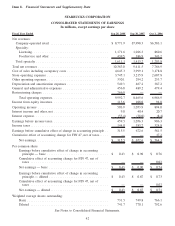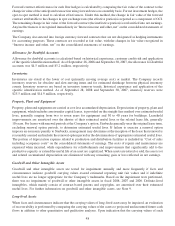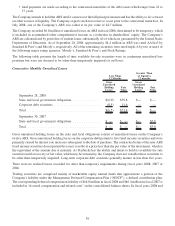Starbucks 2008 Annual Report Download - page 52
Download and view the complete annual report
Please find page 52 of the 2008 Starbucks annual report below. You can navigate through the pages in the report by either clicking on the pages listed below, or by using the keyword search tool below to find specific information within the annual report.STARBUCKS CORPORATION
NOTES TO CONSOLIDATED FINANCIAL STATEMENTS
Fiscal Years ended September 28, 2008, September 30, 2007 and October 1, 2006
Note 1: Summary of Significant Accounting Policies
Description of Business
Starbucks Corporation (together with its subsidiaries, “Starbucks” or the “Company”) purchases and roasts high-
quality whole bean coffees and sells them, along with fresh, rich-brewed coffees, Italian-style espresso beverages,
cold blended beverages, a variety of complementary food items, a selection of premium teas, and coffee-related
accessories and equipment, primarily through its Company-operated retail stores. Starbucks also sells coffee and tea
products and licenses its trademark through other channels such as licensed stores, and, through certain of its equity
investees and licensees, Starbucks produces and sells a variety of ready-to-drink beverages. All channels outside the
Company-operated retail stores are collectively known as specialty operations. Additional details on the nature of
the Company’s business is in Item 1 of this 10-K.
Starbucks has three reportable operating segments: United States, International and Global Consumer Products
Group (“CPG”). See Note 18 for additional details.
Principles of Consolidation
The consolidated financial statements reflect the financial position and operating results of Starbucks, including
wholly owned subsidiaries and investees controlled by the Company. Investments in entities that the Company does
not control, but has the ability to exercise significant influence over operating and financial policies, are accounted
for under the equity method. Investments in entities in which Starbucks does not have the ability to exercise
significant influence are accounted for under the cost method. Intercompany transactions and balances have been
eliminated.
Fiscal Year End
Starbucks Corporation’s fiscal year ends on the Sunday closest to September 30. Some fiscal years include
53 weeks. The fiscal years ended on September 28, 2008, September 30, 2007 and October 1, 2006 included
52 weeks.
Reclassifications
Certain reclassifications of prior year’s balances have been made to conform to the current format, including
separately presenting balances for “Insurance reserves” on the consolidated balance sheet.
Estimates and Assumptions
Preparing financial statements in conformity with accounting principles generally accepted in the United States of
America (“GAAP”) requires management to make estimates and assumptions that affect the reported amounts of
assets, liabilities, revenues and expenses. Actual results may differ from these estimates.
Cash and Cash Equivalents
The Company considers all highly liquid instruments with a maturity of three months or less at the time of purchase
to be cash equivalents. The Company maintains cash and cash equivalent balances with financial institutions that
exceed federally insured limits. The Company has not experienced any losses related to these balances, and
management believes its credit risk to be minimal.
Cash Management
The Company’s cash management system provides for the funding of all major bank disbursement accounts on a
daily basis as checks are presented for payment. Under this system, outstanding checks are in excess of the cash
46
























